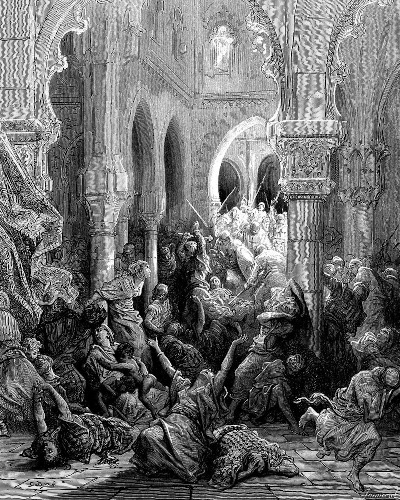The Crusaders Massacre the Inhabitants of Caesarea was depicted within this scene by Gustave Doré as part of his series that focused on the history of the Crusades. There were around 100 illustrations in this project.
Within this composition, we see bright light shining down on the soldiers as they enter this building. They brandish weaponary in an aggressive manner, whilst the locals of this town look on in fear. They are pictured in dark shadows, underlining their mood and also the desperate situation that they find themselves in. Their fate has already been sealed, once the soldiers break through into the building. The artist produced some stunning architectural touches within this scene, mainly along the upper half of the design. We find tall, thick columns with decorative elements added to them, and an arch which spreads across the composition. The reality of the impact of war on ordinary folk is laid bare in front of us here and nothing is hidden from the viewer as we go through another important event in the history of the crusades - the literature was delivered by Michaud, with Doré adding his own illustrations alongside.
Michaud's Histoire des Croisades was illustrated by Doré in 1875, before being published by Paris' Hachette and Co.. The artist had a good relationship with this publisher and had used them several times before. He hired a large number of engravers who could turn his designs into engravings and those items would then be used for the purpose of printing the books. At this time in western Europe, many more people were starting to learn how to read and write, offering a much larger audience to classic literature. Artists like Doré could then make considerable amounts of money by embellishing these publications with some carefully crafted artworks. He would profit greatily from these collaborations and this enabled him to not only employ many assistants within his studio, but also to be able to afford to try out other mediums in his spare time. They were, if you like, his 'bread and butter', and would remain the prominent section of his oeuvre.
In some publications, The Crusaders Massacre the Inhabitants of Caesarea would carry some text below the imagery as follows: "... 30. The Crusaders Massacre the Inhabitants of Caesarea. Baldwin storms the city of Caesarea, ruthlessly killing all of the people." It seems that the literature was honest about the events of the Crusades and would include the horrors that they delivered, rather than just focusing on the positive aspects of victory. Many historians have since referred to this publication and evaluated the accuracy of its writings, in comparison to some of the increased knowledge that we now have available, from an increased set of sources which have been collated together.




